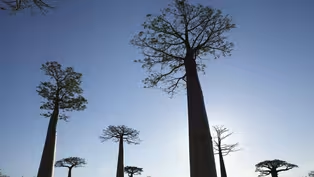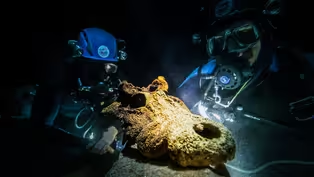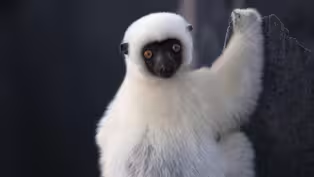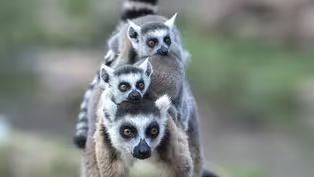
Madagascar
Episode 1 | 54m 40sVideo has Audio Description, Closed Captions
Explore Madagascar, the oldest island on Earth, where life has evolved in unique ways.
The oldest island on Earth, Madagascar has been isolated longer than any other place in the world. Life here has had time to evolve in unusual ways, resulting in more unique wildlife than possibly any other island on the planet.
See all videos with Audio DescriptionADProblems playing video? | Closed Captioning Feedback
Problems playing video? | Closed Captioning Feedback

Madagascar
Episode 1 | 54m 40sVideo has Audio Description, Closed Captions
The oldest island on Earth, Madagascar has been isolated longer than any other place in the world. Life here has had time to evolve in unusual ways, resulting in more unique wildlife than possibly any other island on the planet.
See all videos with Audio DescriptionADProblems playing video? | Closed Captioning Feedback
How to Watch Islands of Wonder
Islands of Wonder is available to stream on pbs.org and the free PBS App, available on iPhone, Apple TV, Android TV, Android smartphones, Amazon Fire TV, Amazon Fire Tablet, Roku, Samsung Smart TV, and Vizio.
Buy Now
Providing Support for PBS.org
Learn Moreabout PBS online sponsorship[ Birds calling ] Narrator: In the tropical waters of the Indian Ocean lies the oldest island on earth... ♪♪ ...Madagascar.
It's home to a staggering array of ancient habitats.
♪♪ From the inhospitable deserts of the West... to the lush rainforests of the East... people and wildlife here have risen to the challenges of this unique place.
♪♪ ♪♪ Isolated for longer than any other island... life has had time to evolve in the most remarkable ways... ♪♪ ♪♪ ...creating a world of wildlife unlike anywhere else on our planet.
♪♪ [ Calling ] ♪♪ Across the globe, islands lie isolated in vast seas... ...home to remarkable animal castaways... ...and extraordinary human cultures.
These islands of wonder cradle precious life found nowhere else on planet Earth.
[ Cracking ] Nearly 90 million years ago, Madagascar was born when one giant landmass, known as Gondwana, broke apart.
♪♪ As Asia split from Africa, Madagascar was cast adrift.
♪♪ At over 200,000 square miles, it's a vast island, almost the size of Texas.
♪♪ At its heart lie the Highlands... ...an immense mountainous spine that defines the island's climate.
♪♪ Warm, wet air is blown in off the Indian Ocean, drenching the East side of Madagascar with rain.
But the mountains block this rain from reaching the West, creating a great expanse of desert.
♪♪ ♪♪ This arid landscape stretches halfway up the West Coast.
And it was here, around 55 million years ago, that a few animal castaways arrived.
It's thought that they survived on rafts of vegetation washed 300 miles across the sea from Africa.
♪♪ And one of the very first mammals to arrive here.
was an ancient species of primate.
Their direct descendants still live in the desert today.
♪♪ ♪♪ Ring-tailed lemurs.
♪♪ ♪♪ In the cool dawn of the desert... they soak up the warmth of the early morning sun... saving vital energy.
[ Birds chirping ] ♪♪ But this young lemur's survival depends on the troop finding enough food... ...not easy when their home is in the harshest corner of this arid world.
♪♪ Known as the Spiny Forest, it's entirely unique to Madagascar... [ Creature squawks ] ♪♪ Miniscule leaves have little to offer a growing lemur.
So the troop must devote up to 8 hours a day scouring this parched desert for food... ...driven to even the most hostile vegetation.
The sticky sap that oozes out of euphorbia plants can be caustic and burn human skin.
♪♪ ♪♪ Yet ringtails are resistant to their corrosive powers.
♪♪ ♪♪ Euphorbia sap is also rich in fats... ♪♪ ...precious fuel for their growing youngster... ♪♪ ...a unique adaptation that may just allow this young lemur to survive the harsh conditions of this hostile desert.
♪♪ Ringtails are just one of the island's many lemurs.
A family of primates found only on Madagascar.
Over millions of years, their ancient ancestors gradually spread out from the arid Western deserts... ♪♪ ...crossing the highlands... ♪♪ ...and eventually arriving in the rainforests of the East.
♪♪ Slowly adapting to the challenges of these remarkable landscapes, they've evolved into over 100 species of lemur.
♪♪ Their story echoes all across Madagascar.
♪♪ Isolated for longer than any other island, those that arrived here have had to become as unique as the island itself.
♪♪ [ Creature whoops ] Just a few thousand years ago, people were the last to arrive on this ancient island.
They, too, had to adapt to Madagascar's vast array of extreme landscapes.
♪♪ ♪♪ On the arid West Coast... the Vezo people rely entirely on the ocean for food.
♪♪ ♪♪ The skills needed to survive are learned at an early age.
And families will spend weeks out at sea, fishing its waters.
♪♪ But not all human colonizers stayed on the coast.
Over time, people pushed further inland... finding ingenious ways to survive the desert.
♪♪ [ Goats bleating ] Just 20 miles from the coast lies the village of Ampotaka.
♪♪ It's October and temperatures reach over 100 degrees.
The dry season here can be long.
not a drop of rain has fallen for 10 months.
With the nearest supply over 40 miles away, life is a daily struggle.
The remains of this year's melon harvest provide just enough water to cook with.
At 62, Adolphe has lived through the driest of years.
[ Adolphe speaking native language ] Narrator: Today, Adolphe is joined by his son Leris to visit an iconic giant... one that holds the key to surviving in this waterless part of the island.
♪♪ The baobab, known as the tree of life.
♪♪ Its thick, gnarled trunk hides an ancient secret.
Naturally holding over twenty thousand gallons of water within its structure, a baobab tree can grow up to 100 feet... ...and survive for three years without a single drop of rain.
These giants have been a lifeline for Adolphe's family for generations.
[ Adolphe speaking native language ] Narrator: By hollowing out the broad trunk, they created a tank in which they could store water through the long dry season.
[ Speaking native language ] Narrator: Each baobab tank can hold hundreds of gallons of water, but this dry season has been long, and their tree is already empty.
It's an important opportunity to trim back the growing bark... maintaining the tank's size.
♪♪ ♪♪ Everything must be prepared for the brief rains ahead.
♪♪ By digging big trenches near the tree... Adolphe and Leris will be able to collect the rainwater and refill their baobab.
♪♪ Adolphe inherited 7 tanks from his father... ♪♪ ♪♪ ...but just one of them still has water inside.
♪♪ [ Adolphe speaking native language ] ♪♪ Narrator: With enough water for just a few weeks, Adolphe can only hope that things will soon change.
Survival in this desert depends on the arrival of the rains.
♪♪ ♪♪ On the forest floor, there are signs that the weather is changing.
Tiny Labord's chameleons, just over an long, begin to hatch.
♪♪ Unique to Madagascar, they live for only four months... the shortest lifespan of any land vertebrate.
♪♪ ♪♪ For this young male, it's a race against time.
♪♪ ♪♪ In the dry season there is little food... but his hatching is perfectly timed.
♪♪ [ Wind blowing ] [ Thunder rumbling ] It's December and the start of the rainy season.
♪♪ ♪♪ ♪♪ The parched landscape is transformed into a flush of green.
♪♪ Just what a growing chameleon needs.
[ Insect buzzing ] ♪♪ With unique eyes that can move independently of each other, he can spot a meal from any direction.
Then, by locking both eyes onto his target, he can judge distance... ...with deadly accuracy.
♪♪ ♪♪ ♪♪ [ Birds calling ] With an abundance of food, he can grow to five times his size.
By February, he's transformed into an adult male, with a striking horn he hopes will catch the eye of a potential mate.
A female approaches.
♪♪ But he's not the only one in pursuit.
With such short lives, there is fierce competition for a chance to mate.
[ Hissing ] ♪♪ [ Hissing ] ♪♪ [ Hissing ] ♪♪ [ Splat ] [ Hissing ] With his rival out of the way, he hasn't got long to take this opportunity before his short life will be over.
♪♪ ♪♪ After just four months, this male and female have succeeded in securing the next generation.
♪♪ As the dry season returns... not a single adult Labord's chameleon will be left alive.
[ Wind blowing ] The entire population existing just as eggs, buried underground, waiting for the next rains to come.
♪♪ ♪♪ Arid regions cover more than half of Western Madagascar... ...including one of its most extreme habitats... ♪♪ ...the Grand Tsingy.
♪♪ More than 500 square miles of sharp limestone pinnacles... ...towering over 400 feet.
They've been slowly eroded by rain over millions of years.
♪♪ The deep ravines hold moisture... allowing tiny pockets of forest to grow.
♪♪ They provide an oasis for an extraordinary lemur... ♪♪ ...found only in this corner of Madagascar... Decken's sifaka.
♪♪ This youngster was born just three months ago... but he's already mastering the vital skill of leaping.
No cluster of trees has enough leaves to sustain a troop of 8.
To provide enough food for her son, this female must seek out fresh vegetation... ...and run a deadly gauntlet... ♪♪ ...crossing the exposed rocks to reach the next pocket of food.
♪♪ ♪♪ The limestone shards are sharp enough to shred human skin.
♪♪ ♪♪ ♪♪ ♪♪ But protected by thick, rubbery soles... and with springy long legs that can leap up to 30 feet... ...these lemurs have evolved into blade runners.
♪♪ ♪♪ ♪♪ ♪♪ ♪♪ ♪♪ Safely across, they claim their reward... ...fresh leaves, essential for both mother and son... Over millions of years, the Decken's sifaka evolved to overcome the extreme conditions of the Grand Tsingy.
But as Madagascar's lemurs continued to spread east across the island... they encountered its most formidable barrier.
over 100 miles east of the Grand Tsingy... the Highlands.
♪♪ ♪♪ It's these towering peaks that create Madagascar's uniquely divided climate.
♪♪ Rising over 6,000 feet... they capture the full force of seasonal rain blowing in from the East.
♪♪ Millions of years of rainfall have carved fertile valleys... prime rice-growing land, the staple food of the people of Madagascar.
Just a few thousand years ago, settlers from Asia brought the skills to turn even the steepest mountains into terraced rice paddies.
Over 1,000,000 tons are produced here every year, all by subsistence farmers.
[ Conversing in native language ] Marivelo owns 4 paddy fields, providing just enough rice for her family of 10.
[ Marivelo speaking native language ] ♪♪ Narrator: It's January, the height of the rainy season, and the most important time for any rice farmer.
♪♪ Each pound of rice needs over 300 gallons of water to grow.
♪♪ With rainwater flooding the rice paddies, Marivelo must now get ready for planting.
♪♪ Instead of plowing the soil, she uses her most prized possession.
♪♪ Originally from Asia, these are zebu cattle.
♪♪ [ Marivelo speaking native language ] ♪♪ ♪♪ Narrator: All the stampeding hooves perfectly churn up the ground.
[ Marivelo speaking native language ] ♪♪ Narrator: An ancient practice, unique to Madagascar, it brings the whole community together.
♪♪ ♪♪ ♪♪ ♪♪ [ Marivelo speaking native language ] [ Cattle lowing ] ♪♪ Narrator: With the soil prepared, it's time to get planting.
♪♪ To make the most of the peak rains, Marivelo and her daughters have to work fast.
All: Whoooo!
[ Marivelo speaking native language ] Narrator: It's a highly skilled task... perfected over generations.
All: Whooo!
They're precision planters.
Despite their speed, every blade is 8 inches apart, ensuring maximum yield.
♪♪ ♪♪ ♪♪ [ Marivelo speaking native language ] Narrator: In three months time, the rice crop should be ready for harvest, providing Marivelo and her family with enough food for the year ahead... ...unless the crop is struck by one of the most destructive creatures on the planet.
Locusts.
♪♪ They're normally solitary insects.
But when there's an abundance of crops... their numbers can reach plague proportions.
♪♪ ♪♪ These flightless marching hoppers devour everything in their path.
♪♪ But their devastation is about to reach a new level.
♪♪ ♪♪ Morphing into fully fledged adults... now they can take to the air in their billions.
♪♪ ♪♪ ♪♪ A swarm this size may only appear once in a decade in Madagascar.
♪♪ ♪♪ ♪♪ Traveling over 50 miles a day... they can consume over 40,000 tons of food... ...including the farmers' precious rice crops.
♪♪ ♪♪ But upon reaching the Highlands... the plague is finally halted by heavy mountain rains.
[ Rain falling ] Wet wings prevent the locusts from flying, until eventually, the swarm runs out of food and dies.
Beyond the Highlands, the land to the east is bathed in warm, wet air, blown in off the Indian Ocean.
Receiving 10 times more rainfall than the West... this side of the island is home to lush rainforests.
♪♪ ♪♪ ♪♪ When Madagascar's ancient castaways eventually made it here, they flourished.
♪♪ ♪♪ ♪♪ ♪♪ ♪♪ Over time, creatures evolved in extraordinary ways colonizing every leaf and vine.
♪♪ Today, two-thirds of the island's unique plants and animals are found here in the Eastern rainforests.
♪♪ ♪♪ [ Insects, birds chirping ] The forest floor provides a haven for another ancient African immigrant.
It may look like a hedgehog, but this is a tenrec, found only on Madagascar.
♪♪ They give birth to more babies than any other mammal... as many as 32 in a single litter.
♪♪ Like the lemurs, they've evolved over time into many different species... adapting in unique ways to their forest home.
[ Birds calling ] At 4 weeks old, these streaked tenrecs are just 5 inches long, but nearly fully grown.
Eagerly sniffing out a meal with their flexible snouts... they can eat over 30 worms a day.
♪♪ ♪♪ In these crowded forests, dangers are everywhere... ♪♪ ♪♪ A deadly Madagascan ground boa.
♪♪ ♪♪ At the first sign of any threat, the mother has an ingenious way to raise the alarm.
[ Spines scraping ] She rubs together modified spines on her back, creating a high-pitched sound that's hard for US to hear, but not for her young.
[ Spines scraping ] Cutting through the noise of the forest, the youngsters quickly home in on her alarm call.
[ Spines scraping ] ♪♪ ♪♪ This unique form of communication is used by no other mammal on the planet.
♪♪ ♪♪ The sheer abundance of life here has resulted in some of the island's most unusual creatures... each evolving in extreme ways to beat the competition.
♪♪ ♪♪ Under the cover of darkness, the pelican spider emerges... ♪♪ ...aptly named for their long jaws.
♪♪ ♪♪ He can produce silk, but he doesn't build a web to catch food.
Instead, he hunts down his next meal.
Using his extra long arms... he searches for clues... ...like a silk thread.
♪♪ Following these guidelines leads him straight to his prey... ♪♪ ...because this spider is a spider killer.
Silently he can creep up on his unsuspecting victim.
♪♪ ♪♪ Not so simple when your dinner has eight eyes.
♪♪ ♪♪ But he is a persistent hunter.
Another potential victim -- a female orb web spider.
♪♪ But in the safety of her web, she's surrounded by a sticky fortress.
What to do?
Fortunately, the pelican spider has had millions of years to fine-tune his technique.
♪♪ ♪♪ Mimicking the movements of a struggling fly, he lures her towards him.
♪♪ ♪♪ ♪♪ His massive, pelican jaws hold her safely away from his body, avoiding her lethal bite.
And only after he's injected her with his own venom is it safe to have his dinner.
[ Insects chirping ] ♪♪ ♪♪ With such intense competition for food in these Eastern rainforests, even Madagascar's lemurs have been pushed to evolve in the most extreme ways.
♪♪ ♪♪ This is an aye-aye... filmed in a special enclosure.
[ Aye-aye chirping ] ♪♪ Her favorite food is insect larvae, which can only be found deep inside the branches of trees.
[ Aye-aye sniffing ] But the aye-aye has evolved a truly unique way of hunting them down... a technique that's thought to take 4 years to master.
By tapping on the tree, she can hear where the branch is hollow.
♪♪ ♪♪ But one of her highly adapted fingers has another job.
♪♪ ♪♪ At 3.5 inches long, it's perfect for hooking out grubs.
♪♪ [ Aye-aye chirping ] Madagascar's unique wildlife has had millions of years to slowly evolve.
But in the last few thousand years, the pace of change of island life has increased rapidly, with some devastating consequences... ...examples of which have only just been discovered... in Madagascar's remote Western desert.
[ Birds calling ] This pool is a portal to a previously unexplored world.
♪♪ In 2015, divers ventured into a vast network of flooded passages.
♪♪ ♪♪ ♪♪ ♪♪ ♪♪ Over 160 feet below the surface, they entered a truly magical underworld... discovering over 7 miles of connected tunnels... ...and some of the biggest underwater chambers in the world.
♪♪ ♪♪ But it's what they found inside these caves that was their most astounding discovery.
A vast graveyard... the preserved remains of mysterious creatures.
♪♪ ♪♪ Horned crocodiles.
♪♪ A puma-like predator, and even pygmy hippos.
But most impressive of all... the skulls of giant lemurs that grew to the size of a gorilla.
♪♪ All now extinct on Madagascar.
♪♪ Their demise coincided with the most disruptive change in Madagascar's long history.
Just a few thousand years ago, the arrival of people.
♪♪ ♪♪ ♪♪ Today, our impact on the island is greater than ever before.
Madagascar's forests are disappearing faster than in any other tropical country... cleared mainly for subsistence farming.
As little as 20% of the island's original forest remains.
[ Creatures calling ] And the impact on Madagascar's unique wildlife has been devastating.
♪♪ 95% of lemurs are now threatened with extinction... ...making them the most vulnerable group of mammals in the world.
♪♪ ♪♪ ♪♪ One of the most endangered is found in the East of the island, the greater bamboo lemur.
Like all lemurs, they are highly specialized.
Bamboo makes up nearly 95% of their diet... ...despite the fact that these shoots are packed full of deadly cyanide.
Every day each lemur can eat enough poison to kill 5 humans... ...surviving only because they have evolved to withstand its toxic effects.
This unique adaptation means they have these thickets all to themselves... but it also means they're trapped here, unable to live anywhere else.
As their bamboo forests are cleared for agriculture... ...the lemurs are left with little to eat and quickly disappear.
♪♪ The greater bamboo lemur was once thought to have gone extinct.
But thanks to a recent concerted effort to protect them... there is now a glimmer of hope.
♪♪ ♪♪ In the last year, this group had a record number of babies, adding 72 to their total population of just 500.
♪♪ ♪♪ ♪♪ ♪♪ The greater bamboo lemur is just one of thousands of remarkable creatures found only on Madagascar... ♪♪ ...each one conquering the challenges that they've faced here over millions of years.
♪♪ From the arid deserts of the West... ♪♪ ...to the island's mountainous heart... ♪♪ ...and into the lush rainforests of the East... ♪♪ ♪♪ ...now they face the challenges of our changing world.
♪♪ ♪♪ But with our protection, there is hope that this ancient island of wonder can continue to thrive for millions of years to come.
♪♪ ♪♪ ♪♪ To order "Islands of Wonder" on DVD, visit ShopPBS.org or call 1-800-PLAY-PBS.
This program is also available on Amazon Prime Video.
♪♪ ♪♪
Video has Closed Captions
Clip: Ep1 | 3m 47s | The residents of Ampotaka rely on the baobab trees during Madagascar's dry season. (3m 47s)
The History Hidden in Madagascar’s Underwater Caves
Video has Closed Captions
Clip: Ep1 | 3m 6s | In Madagascar’s remote western desert, divers explore a hidden pool of water. (3m 6s)
Lemurs Navigate the Grand Tsingy
Video has Closed Captions
Clip: Ep1 | 3m 47s | The decken’s sifaka cross miles of exposed rock to feed themselves and their young. (3m 47s)
Ring-Tailed Lemurs Battle Tough Terrain Searching for Food
Video has Closed Captions
Clip: Ep1 | 2m 2s | In the spiny forests of Madagascar, ring-tail lemur troops search for food. (2m 2s)
Providing Support for PBS.org
Learn Moreabout PBS online sponsorship
- Science and Nature

Explore scientific discoveries on television's most acclaimed science documentary series.

- Science and Nature

Capturing the splendor of the natural world, from the African plains to the Antarctic ice.












Support for PBS provided by:



